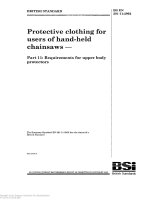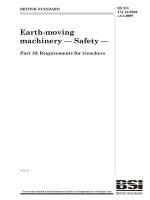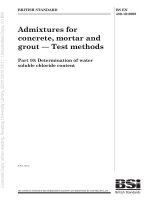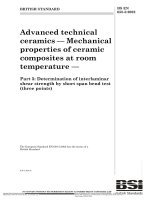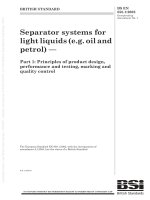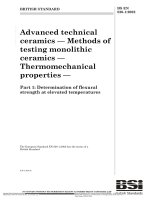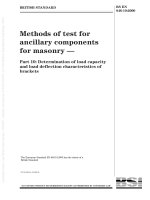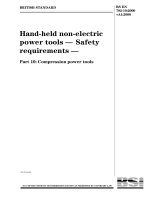Bsi bs en 60127 10 2002 (iec 60127 10 2001)
Bạn đang xem bản rút gọn của tài liệu. Xem và tải ngay bản đầy đủ của tài liệu tại đây (365.17 KB, 20 trang )
Licensed Copy: Sun Yat-Sen University User, Sun Yat-Sen University, Mon Sep 26 09:14:26 BST 2005, Uncontrolled Copy, (c) BSI
BRITISH STANDARD
BS EN
60127-10:2002
IEC
60127-10:2001
Miniature fuses —
Part 10: User guide for miniature fuses
The European Standard EN 60127-10:2002 has the status of a
British Standard
ICS 29.120.50
NO COPYING WITHOUT BSI PERMISSION EXCEPT AS PERMITTED BY COPYRIGHT LAW
Licensed Copy: Sun Yat-Sen University User, Sun Yat-Sen University, Mon Sep 26 09:14:26 BST 2005, Uncontrolled Copy, (c) BSI
BS EN 60127-10:2002
National foreword
This British Standard is the official English language version of
EN 60127-10:2002. It is identical to IEC 60127-10:2001.
The UK participation in its preparation was entrusted to Technical Committee
PEL/32, Fuses, which has the responsibility to:
—
aid enquirers to understand the text;
—
present to the responsible international/European committee any
enquiries on the interpretation, or proposals for change, and keep the
UK interests informed;
—
monitor related international and European developments and
promulgate them in the UK.
A list of organizations represented on this committee can be obtained on
request to its secretary.
From 1 January 1997, all IEC publications have the number 60000 added to
the old number. For instance, IEC 27-1 has been renumbered as IEC 60027-1.
For a period of time during the change over from one numbering system to the
other, publications may contain identifiers from both systems.
Cross-references
Attention is drawn to the fact that CEN and CENELEC Standards normally
include an annex which lists normative references to international
publications with their corresponding European publications. The British
Standards which implement these international or European publications may
be found in the BSI Standards Catalogue under the section entitled
“International Standards Correspondence Index”, or by using the “Find”
facility of the BSI Standards Electronic Catalogue.
A British Standard does not purport to include all the necessary provisions of
a contract. Users of British Standards are responsible for their correct
application.
Compliance with a British Standard does not of itself confer immunity
from legal obligations.
This British Standard, having
been prepared under the
direction of the
Electrotechnical Sector Policy
and Strategy Committee, was
published under the authority
of the Standards Policy and
Strategy Committee on
22 March 2002
Summary of pages
This document comprises a front cover, an inside front cover, the EN title page,
pages 2 to 17 and a back cover.
The BSI copyright date displayed in this document indicates when the
document was last issued.
Amendments issued since publication
Amd. No.
© BSI 22 March 2002
ISBN 0 580 39232 5
Date
Comments
Licensed Copy: Sun Yat-Sen University User, Sun Yat-Sen University, Mon Sep 26 09:14:26 BST 2005, Uncontrolled Copy, (c) BSI
EUROPEAN STANDARD
EN 60127-10
NORME EUROPÉENNE
EUROPÄISCHE NORM
January 2002
ICS 29.120.50
English version
Miniature fuses
Part 10: User guide for miniature fuses
(IEC 60127-10:2001)
Coupe-circuit miniatures
Part 10: Guide d'utilisation
pour coupe-circuit miniatures
(CEI 60127-10:2001)
Geräteschutzsicherungen
Teil 10: Leitfaden für die Anwendung
von Geräteschutzsicherungen
(IEC 60127-10:2001)
This European Standard was approved by CENELEC on 2002-02-01. CENELEC members are bound to
comply with the CEN/CENELEC Internal Regulations which stipulate the conditions for giving this European
Standard the status of a national standard without any alteration.
Up-to-date lists and bibliographical references concerning such national standards may be obtained on
application to the Central Secretariat or to any CENELEC member.
This European Standard exists in three official versions (English, French, German). A version in any other
language made by translation under the responsibility of a CENELEC member into its own language and
notified to the Central Secretariat has the same status as the official versions.
CENELEC members are the national electrotechnical committees of Austria, Belgium, Czech Republic,
Denmark, Finland, France, Germany, Greece, Iceland, Ireland, Italy, Luxembourg, Malta, Netherlands,
Norway, Portugal, Spain, Sweden, Switzerland and United Kingdom.
CENELEC
European Committee for Electrotechnical Standardization
Comité Européen de Normalisation Electrotechnique
Europäisches Komitee für Elektrotechnische Normung
Central Secretariat: rue de Stassart 35, B - 1050 Brussels
© 2002 CENELEC - All rights of exploitation in any form and by any means reserved worldwide for CENELEC members.
Ref. No. EN 60127-10:2002 E
Page 2
Licensed Copy: Sun Yat-Sen University User, Sun Yat-Sen University, Mon Sep 26 09:14:26 BST 2005, Uncontrolled Copy, (c) BSI
EN 60127−10:2002
Foreword
The text of document 32C/294/FDIS, future edition 1 of IEC 60127-10, prepared by SC 32C, Miniature
fuses, of IEC TC 32, Fuses, was submitted to the IEC-CENELEC parallel vote and was approved by
CENELEC as EN 60127-10 on 2002-02-01.
The following dates were fixed:
– latest date by which the EN has to be implemented
at national level by publication of an identical
national standard or by endorsement
(dop) 2002-11-01
– latest date by which the national standards conflicting
with the EN have to be withdrawn
(dow) 2005-02-01
Annexes designated "normative" are part of the body of the standard.
In this standard, annex ZA is normative.
Annex ZA has been added by CENELEC.
__________
Endorsement notice
The text of the International Standard IEC 60127-10:2001 was approved by CENELEC as a European
Standard without any modification.
__________
© BSI 22 March 2002
Page 3
Licensed Copy: Sun Yat-Sen University User, Sun Yat-Sen University, Mon Sep 26 09:14:26 BST 2005, Uncontrolled Copy, (c) BSI
EN 60127−10:2002
CONTENTS
INTRODUCTION .................................................................................................................... 3
1
Scope .............................................................................................................................. 5
2
Normative references....................................................................................................... 5
3
Properties of miniature fuses ........................................................................................... 6
4
Different types of fuse-links ............................................................................................. 6
4.1 Characteristics .......................................................................................................... 7
4.2 Breaking capacity ...................................................................................................... 7
4.3 Cartridge fuse-links (IEC 60127-2) ............................................................................ 7
4.4 Sub-miniature fuse-links (IEC 60127-3) ..................................................................... 8
4.5 Universal Modular Fuse-links (IEC 60127-4) .............................................................. 9
5
Applications ..................................................................................................................... 9
5.1 Applications – Fuse selection criteria......................................................................... 9
5.2 Electrical criteria ......................................................................................................10
5.3 Mechanical/physical dimensions ...............................................................................10
6
Protection by I t limitation and pulse operation ...............................................................10
6 . 1 I t value ..................................................................................................................10
6.2 Pulse operation .......................................................................................................11
2
6 . 3 I t limitation.............................................................................................................11
7
Direct current (d.c.) applications .....................................................................................11
7.1 General information ..................................................................................................11
7.2 Battery circuits .........................................................................................................12
7.3 Inductive load circuits ...............................................................................................12
8
Fuse-holders...................................................................................................................12
8.1 Features ...................................................................................................................12
8.2 Safety aspects..........................................................................................................12
8.3 Selection of a fuse-holder .........................................................................................12
8.4 Exchange of fuse-links under load ............................................................................13
9
Performance on extra-low voltages .................................................................................13
10 Influence of ambient temperature....................................................................................14
Bibliography ..........................................................................................................................16
Annex ZA (normative) Normative references to international publications with their
corresponding European publications .............................................................................17
© BSI 22 March 2002
Page 4
Licensed Copy: Sun Yat-Sen University User, Sun Yat-Sen University, Mon Sep 26 09:14:26 BST 2005, Uncontrolled Copy, (c) BSI
EN 60127−10:2002
INTRODUCTION
The users of miniature fuses express the wish that all standards, recommendations and other
documents relating to miniature fuses should have the same publication number in order to
facilitate reference to fuses in other specifications, for example, equipment specifications.
Furthermore, a single publication number and subdivision into parts would facilitate the
establishment of new standards, because clauses and subclauses containing general requirements need not be repeated.
The new IEC 60127 series is thus subdivided as follows:
IEC 60127, Miniature fuses (general title)
Part 1: Definitions for miniature fuses and general requirements for miniature fuse-links
Part 2: Cartridge fuse-links
Part 3: Sub-miniature fuse-links
Part 4: Universal Modular Fuse-links (UMF)
Part 5: Guidelines for quality assessment of miniature fuse-links
Part 6: Fuse-holders for miniature cartridge fuse-links
Part 7: (Free for further documents)
Part 8: (Free for further documents)
Part 9: (Free for further documents)
Part 10: User guide for miniature fuses
© BSI 22 March 2002
Page 5
Licensed Copy: Sun Yat-Sen University User, Sun Yat-Sen University, Mon Sep 26 09:14:26 BST 2005, Uncontrolled Copy, (c) BSI
EN 60127−10:2002
MINIATURE FUSES –
Part 10: User guide for miniature fuses
1 Scope
This part of IEC 60127 relates to miniature fuses for the protection of electric appliances,
electronic equipment and component parts thereof, normally intended to be used indoors, as
specified in IEC 60127-2, 60127-3 and 60127-4.
This standard does not apply to fuses for appliances intended to be used under special
conditions, such as in a corrosive or explosive atmosphere.
It relates to fuse-holders for miniature fuse-links according to IEC 60127-6.
The object of this guide is to introduce the user to the important properties of miniature fuselinks and fuse-holders for miniature fuses-links and to give some guidance on applying them.
NOTE 1
If the performance of IEC 60127 fuses proves inadequate, refer to IEC 60269.
NOTE 2 Fuse-links of the same type and rating may, due to differences in design, have different voltage drops
and different behaviours. Therefore, in practice, they may not be interchangeable when used in applications with
low-circuit voltages, especially in combination with fuse-links of lower rated currents.
NOTE 3
2
Contact the manufacturer for further information.
Normative references
The following normative documents contain provisions which, through reference in this text,
constitute provisions of this part of IEC 60127. For dated references, subsequent amendments to, or revisions of, any of these publications do not apply. However, parties to
agreements based on this part of IEC 60127 are encouraged to investigate the possibility of
applying the most recent editions of the normative documents indicated below. For undated
references, the latest edition of the normative document referred to applies. Members of IEC
and ISO maintain registers of currently valid International Standards.
IEC 60127-2:1989, Miniature fuses – Part 2: Cartridge fuse-links
IEC 60127-3:1988, Miniature fuses – Part 3: Sub-miniature fuse-links
IEC 60127-4:1996, Miniatures fuses – Part 4: Universal Modular Fuse-links (UMF)
IEC 60127-6:1994, Miniature fuses – Part 6: Fuse-holders for miniature cartridge fuse-links
IEC 60269 (all parts), Low-voltage fuses
© BSI 22 March 2002
Page 6
Licensed Copy: Sun Yat-Sen University User, Sun Yat-Sen University, Mon Sep 26 09:14:26 BST 2005, Uncontrolled Copy, (c) BSI
EN 60127−10:2002
3 Properties of miniature fuses
The miniature fuse provides protection against the effects of short circuits and sustained
overloads, protecting components and conductors upstream of the fault and isolating the
faulty branch of the circuit downstream of the fault. The opening of the fuse-link also acts as a
diagnostic tool, helping to identify the location of the fault. These properties include:
·
Wide range of physical types of construction: miniature fuses are available in a wide
choice of physical constructions. For example, there are fuse-links that can be fitted into
clips and fuse-holders or plugged into sockets enabling easy replacement. There are also
types which can be soldered on to printed wiring boards by through-hole mounting or
surface mounting, using wave soldering or reflow soldering.
·
Low cost and very small dimensions: miniature fuses provide very good circuit
protection in a small package suitable for miniaturized equipment.
·
Wide range of characteristics: miniature fuses are generally used within electronic
equipment, where prospective short-circuit currents are below 1 500 A. Fuses are
available with a very wide range of characteristics, from (very) quick acting types to (long)
time-lag types. The latter types are very useful because they can withstand inrush
currents experienced during switching on, but will also open under sustained overloads.
·
Discrimination (selectivity): standardized fuse characteristics and limitation of letthrough energy ensure that a faulty circuit is isolated by the fuse without opening higher
rated upstream fuses, avoiding disconnection of the supply to healthy circuits downstream.
·
Reliability: miniature fuses carry operational currents continuously without any substantial
change or deterioration in their characteristics, and give equal protection to that provided
by a new fuse. During their long life, no maintenance is required.
·
Tamper-proof reproducible characteristics: miniature fuses provide a package of
protection tailor-made for the application. The same level of protection is then maintained
by a replacement fuse-link of the same type and rating, fitted after the fault has been
corrected. The extensive schedule of tests in the IEC 60127 series together with a quality
system such as that described in IEC 60127-5 and a follow-up service by a National
Certification Body, ensure that all aspects of fuse operation are accurately and safely
reproduced at any location world-wide.
·
Arc dissipation: suitable fuses can disconnect faults so quickly that there is no time for
an arc to become established at the fault location.
4 Different types of fuse-links
IEC 60127 makes reference to three families of fuse-links:
·
IEC 60127-2
Cartridge fuse-links
·
IEC 60127-3
Sub-miniature fuse-links
·
IEC 60127-4
Universal Modular Fuse-links (UMF)
© BSI 22 March 2002
Page 7
Licensed Copy: Sun Yat-Sen University User, Sun Yat-Sen University, Mon Sep 26 09:14:26 BST 2005, Uncontrolled Copy, (c) BSI
EN 60127−10:2002
4.1 Characteristics
These are terms that define how quickly a fuse-link will operate (open) at various overload
current levels. Fuses conforming to the standard sheets in the various parts of IEC 60127 are
characterized as follows:
·
FF –
Very quick acting
·
F
–
Quick acting
·
M
–
Medium time-lag
·
T
–
Time-lag
·
TT –
Long time-lag
The individual standard sheets specify precise time gates for each overload current level,
given as a multiple of the rated current. The fuse-element must melt within the given time
gate.
It should be noted that the characteristics of fuses conforming to other standards, such as
CSA-C22.2 No. 248.14 ă UL 248-14 [1] 1, could be quite different from the IEC 60127
characteristics. Additionally, these other standards may not specify the same characteristic
definitions or precise time gates. Accordingly, the definition of terms such as very fast acting,
fast acting, quick acting, normal acting, medium acting, medium blow, time lag, time delay and
others are left to the individual fuse manufacturers, and can vary widely.
4.2 Breaking capacity
The breaking capacity of a fuse is the value of current that a fuse can safely interrupt at its
rated voltage. The value assigned by the fuse manufacturer is usually that prescribed in the
standard sheet, for a given voltage and other specified test conditions such as circuit power
factor, closing angle, etc. In practice, a fuse shall not be used in a circuit that has a potential
fault (short-circuit) current greater than the rated breaking capacity of the fuse. It is usually
difficult to determine the actual maximum potential fault current of a circuit/application. Often
it is an assumed theoretical value assigned by a safety agency. In some cases, the suitability
of a fuse’s breaking capacity is determined by testing the fuse in the end product, under
short-circuit conditions.
4.3 Cartridge fuse-links (IEC 60127-2)
Two sizes of fuse-links are described: 5 mm ´ 20 mm and 6,3 mm ´ 32 mm. The details are
specified in six standard sheets. The rated voltage is 250 V a.c. except for those fuse-links
shown in standard sheet 4, which are rated 250 V for 50 mA through 2 A; 150 V for 2,5 A
through 4 A and 60 V for 6,3 A through 10 A.
———————
1 References in square brackets refer to the bibliography.
© BSI 22 March 2002
Page 8
Licensed Copy: Sun Yat-Sen University User, Sun Yat-Sen University, Mon Sep 26 09:14:26 BST 2005, Uncontrolled Copy, (c) BSI
EN 60127−10:2002
Standard sheet
Dimensions
mm
Characteristic
1
5 ´ 20
F
High (1 500 A)
2
5 ´ 20
F
Low (35 A or 10 I N )*
3
5 ´ 20
T
Low (35 A or 10 I N )*
4
6,3 ´ 32
F
Low (35 A or 10 I N )*
5
5 ´ 20
T
High (1 500 A)
6
5 ´ 20
T
Enhanced (150 A)
*
Rated breaking
capacity
Whichever is greater.
NOTE These fuse-links are available in wire terminated form for direct connection to printed wiring boards
(excluding standard sheet 4).
4.4 Sub-miniature fuse-links (IEC 60127-3)
This standard consists of four standard sheets, all of which refer to low breaking capacity
fuse-links. Two types of fuse-links are described, radial and axial, for use on printed wiring
boards.
Standard sheet
Termination
Characteristic
1
radial
F
Low (50 A)
2
axial
F
Low (50 A)
3
radial
F
Low (35 A or 10 I N )*
4
radial
T
Low (35 A or 10 I N )*
*
Rated breaking
capacity
Whichever is greater.
The spacing of the fuse-link terminations are designed to permit easy installation on printed
wiring boards having a grid system of holes located at 2,54 mm between centres. Care should
be taken that creepage and clearance distances are maintained.
© BSI 22 March 2002
Page 9
Licensed Copy: Sun Yat-Sen University User, Sun Yat-Sen University, Mon Sep 26 09:14:26 BST 2005, Uncontrolled Copy, (c) BSI
EN 60127−10:2002
4.5 Universal Modular Fuse-links (IEC 60127-4)
Two types of fuse-link are described, through-hole types (standard sheet 1) and surface
mount types (standard sheet 2) with rated voltages of 32 V, 63 V, 125 V and 250 V.
Standard sheet
Rated
voltage
V
Terminal spacing , b
Characteristic
Rated breaking capacity
mm
32
2,5
FF, F, T or TT
Low (35 A or 10 I N ) a
63
2,5
FF, F, T or TT
Low (35 A or 10 I N ) a
125
5
FF, F, T or TT
Low (50 A or 10 I N ) a
250
7,5
FF, F, T or TT
Low (100 A)
250
10
FF, F, T or TT
Intermediate (500 A)
250
12,5
FF, F, T or TT
High (1 500 A)
2
32
1,5
FF, F, T or TT
Low (35 A or 10 I N ) a
(Surface mount)
63
2
FF, F, T or TT
Low (35 A or 10 I N ) a
125
2,5
FF, F, T or TT
Low (50 A or 10 I N ) *
250
4
FF, F, T or TT
Low (100 A)
250
4
FF, F, T or TT
Intermediate (500 A)
250
4
FF, F, T or TT
High (1 500 A)
1
(Through-hole)
a
Whichever is greater.
b
For surface mounted fuse-links, minimum terminal spacing values apply.
This area of fuse design is developing rapidly. The standard acknowledges this by not being
design restrictive, merely specifying maximum dimensions for physical size. To ensure that
fuse-links from different manufacturers are interchangeable some investigation may be
needed.
5 Applications
5.1 Applications – Fuse selection criteria
Selection of a miniature fuse for a given application is usually dictated by three basic
categories of criteria:
a) electrical requirements of the application;
b) conformance to published fuse safety standards;
c) mechanical properties/physical size.
It is necessary to first determine the electrical performance required of the fuse, as dictated
by the application, and usually, safety agency test requirements for the end product. The
electrical characteristics and breaking capacity needed for the application shall conform to a
published safety standard. This conformance is usually confirmed by third party (safety
agency) approval of the fuse.
Only after these criteria are met can the mechanical/dimensional attributes be considered.
© BSI 22 March 2002
Page 10
Licensed Copy: Sun Yat-Sen University User, Sun Yat-Sen University, Mon Sep 26 09:14:26 BST 2005, Uncontrolled Copy, (c) BSI
EN 60127−10:2002
5.2 Electrical criteria
The electrical ratings and performance required of a fuse are dictated by:
a) normal operating conditions of the end product, i.e. steady state current, supply voltage,
ambient temperature, etc.;
b) foreseeable field fault conditions due to failures within the end product;
c) foreseeable field fault conditions due to power line crossing or other surges (e.g.
lightning);
d) specified overload and short-circuit test conditions imposed by safety agencies on the end
product.
The following information should be considered for each particular application:
1) The circuit-operating voltage and whether it is alternating current (a.c.) or direct current
(d.c.).
2) Any transient conditions that exist, for example:
i)
the maximum inrush current at product “switch-on” (including its waveform and
duration) that the fuse shall withstand without opening;
ii) the anticipated usage pattern or duty cycle: will the end product be switched on once a
day, once a week, once a year, etc. or continuously cycled?;
iii) any pulse current surges due to secondary lightning surges (amplitude, waveform and
number of cycles) that the fuse shall withstand without opening.
3) Normal operating conditions:
i)
maximum steady-state current that the fuse will be subjected to in service;
ii) minimum/maximum ambient conditions.
4) Circuit protection performance required:
i)
minimum overload current at which the fuse shall operate, and the maximum time
allowed to operate (open);
ii) other critical overload level or time constraints that the fuse shall meet;
iii) maximum short-circuit current and voltage that the fuse shall interrupt.
5.3 Mechanical/physical dimensions
Once the electrical requirements and any safety approval issues are determined, then the
mechanical options can be addressed.
6 Protection by I t limitation and pulse operation
6.1 I t value
Pre-arcing (melting) I t or ‘Joule Integral’ is a measure of the energy required to melt the
2
fuse-element and is expressed as “ampere squared seconds” (A s). For sufficiently high
currents, pre-arcing I t and the energy it represents is a constant value for each different
fuse-element. Because every fuse type and rating has a different fuse-element, it is necessary
2
2
to determine the I t for each. This I t value is a parameter of the fuse itself and is determined
2
by the element material and configuration. This nominal pre-arcing I t is not only a constant
value for each fuse-element design, but it is independent of voltage and substantially
independent of temperature.
© BSI 22 March 2002
Page 11
Licensed Copy: Sun Yat-Sen University User, Sun Yat-Sen University, Mon Sep 26 09:14:26 BST 2005, Uncontrolled Copy, (c) BSI
EN 60127−10:2002
2
The operating I t is a measure of the let-through energy of the fuse and is the sum of the pre2
2
arcing and arcing I t. The arcing I t is not determined solely by the fuse itself, but by the
circuit’s parameters.
6.2 Pulse operation
2
Usually, the pre-arcing I t is used to select a fuse for an application where it is necessary to
sustain large current pulses of a short duration. These currents are common in many
applications and are described by a variety of terms, such as “surge current”, “start-up
current”, “inrush current” and other similar circuit “transients” that can be classified in the
2
general category of “pulses”. It is important to take into account the I t and repetition rate of
the pulse. In order to avoid nuisance opening, it is necessary to select a fuse with a pre2
2
arcing I t sufficiently larger than the pulse I t.
2
6.3 I t limitation
2
For protection of sensitive components, the operating I t is the important parameter.
Components such as semi-conductors have a withstand rating which gives the amount of
energy which they can handle without failure. For this application, unlike pulse operations, it
2
is important to select a fuse that has an operating I t less than the component withstand
rating.
2
Conclusion: select the I t value of the fuse so that
2
2
a) the I t inrush pulse is less than the pre-arcing I t value of the fuse;
2
2
b) the operating I t value of the fuse is less than the maximum I t value of the device that
has to be protected.
NOTE IEC subcommittee 32C suggest measuring I 2 t at 10 I N . This can lead to overstated values, particularly with
time lag fuse-links whose operating time at 10 I N is usually significantly greater than fast acting types. Published I 2 t
values are generally nominal and the factory should be consulted if this parameter is critical to the design analysis.
7 Direct current (d.c.) applications
7.1 General information
While published fuse rating information is based on a.c. data and may not be applicable for
d.c. applications, all fuses shall operate in both a.c. and d.c. circuits. However, the d.c. rated
voltage and rated breaking capacity may be different from the a.c. ratings of the fuse-link. To
select a fuse for d.c. applications, the circuit time constant shall be determined and the basic
ratings for the fuse-link shall be verified for d.c. performance.
Typical d.c. applications include:
·
batteries/accumulators which are comparatively low voltage (less than 50 V) but with
potentially high fault currents;
·
telecommunications or power supplies up to 125 V where the fault current is within the a.c.
breaking capacity limit of the fuse-link;
·
d.c. voltages above 125 V where additional testing may be necessary, particularly for
breaking capacity.
© BSI 22 March 2002
Page 12
Licensed Copy: Sun Yat-Sen University User, Sun Yat-Sen University, Mon Sep 26 09:14:26 BST 2005, Uncontrolled Copy, (c) BSI
EN 60127−10:2002
Inductive and capacitive d.c. circuits need additional considerations because of the stored
energy, characterized by the circuit time constant. This value is usually less than 2 ms for
battery circuits and up to about 4 ms for other inductive circuits that can typically be protected
by miniature fuses. This circuit characteristic may affect the operating time/current
characteristics, rated voltage and breaking capacity performance of the fuse. Time-current
curves are usually based on a.c. (r.m.s.) or d.c. currents that are thermally equivalent.
7.2 Battery circuits
Batteries contain very little inductance. To select a fuse for a battery circuit, determine the
circuit time constant and consider the following fuse information:
·
time current data: develop from either a.c. (r.m.s.) or d.c. current;
·
d.c. voltage rating: equal to or greater than the d.c. circuit voltage;
·
d.c. breaking capacity: equal to or greater than the circuit's available d.c. fault current.
The time constant for the fuse breaking capacity test shall be equal to or exceed the time
constant of the d.c. application circuit.
7.3 Inductive load circuits
Loads such as motors, solenoids and other coil-type loads may have a large amount of
inductance. To select a fuse for these applications, follow the procedure for battery circuits.
8 Fuse-holders
8.1 Features
Allows replacement of the fuse-link without any auxiliary means and without opening the
equipment (panel mounted fuse-holder).
8.2 Safety aspects
In view of the safety of electrical equipment, the selection of the most suitable fuse-holder is
of great importance. Among other parameters, one has to make sure that the admissible
power acceptances and temperatures defined by the fuse-holder manufacturer are followed.
To choose a fuse-holder based only on the rated current of a fuse-link may, especially at
higher currents, cause unacceptable temperatures if the effect of the heat generated in the
contacts of the fuse-holder has not been taken into consideration.
8.3 Selection of a fuse-holder
The following parameters shall be considered:
a) maximum sustained dissipation of the fuse-link;
b) rated power acceptance of the fuse-holder, temperatures surrounding the fuse-holder and
operating current;
c) the difference between the ambient air temperature outside and inside the equipment;
d) heat dissipation/cooling, ventilation, heat influence of adjacent components.
The rated power acceptance is a measure of the maximum power dissipation that the fuseholder can handle without exceeding its temperature rise limits. It is intended to be the power
dissipation caused by an inserted dummy fuse-link at the rated current of the fuse-holder and
at an ambient temperature of 23 °C.
© BSI 22 March 2002
Page 13
Licensed Copy: Sun Yat-Sen University User, Sun Yat-Sen University, Mon Sep 26 09:14:26 BST 2005, Uncontrolled Copy, (c) BSI
EN 60127−10:2002
The correlation between ambient air temperature and the rated power acceptance of a fuseholder for one or several operating currents is demonstrated by derating curves published by
the fuse-holder manufacturer.
To keep the power dissipation of the fuse-link inserted in the fuse-holder below the rated
power acceptance of the fuse-holder, at the corresponding ambient air temperature and
mounting conditions, it is necessary to observe the following two steps:
8.3.1 Step 1
Selection of the fuse-holder is based on the power acceptance at operating current and
maximum ambient air temperature. The maximum sustained dissipation of the fuse-link shall
be less than or equal to the admissible power acceptance of the fuse-holder.
8.3.2 Step 2
The reduction of the power acceptance of the fuse-holder (from step 1) based on the different
conditions at the mounting place etc. shall be determined by the responsible design engineer.
Examples:
–
ambient air temperature is considerably higher inside the equipment than outside;
–
cross-section of the conductor;
–
unfavourable heat dissipation;
–
heat influence of adjacent components.
8.4 Exchange of fuse-links under load
A fuse-holder with an installed fuse-link shall not be used as a “switch” for turning the power
on and off. In order to prevent damage to the fuse-holder, a fuse-link shall only be exchanged
when the power in the circuit is switched off.
9 Performance on extra-low voltages
In a wide range of applications, miniature fuse-links provide reliable protection against fault
current conditions, and have negligible influence on the circuit.
© BSI 22 March 2002
Page 14
However, consideration should be given when fuse-links are used at extra-low voltages, i.e. in
the range of 10 V, especially for fuse-links of low rated current. For a fuse-link having a rated
current lower than 100 mA, its cold resistance can be between 1 W and 100 W, i.e. the
impedance of the fuse-link may possibly be as high as the impedance of the circuit. The
voltage drop of low-rated fuse-links is relatively high; it is in the range of 1 V. In contrast to
this, the power dissipation of approximately 0,5 W is negligible.
The typical relationship between voltage drop and power dissipation dependent on rated
current is shown in figure 1 below.
Due to the non-linear increase of the voltage drop when the fuse-element approaches its
melting point, care shall be taken to ensure that there is sufficient voltage available to cause
the fuse-link to interrupt the current when an electrical fault occurs.
4
1 000
U
3
100
2
10
1
P
1
10
100
1 000
Power dissipation
P W
5
10 000
Voltage drop
U mV
Licensed Copy: Sun Yat-Sen University User, Sun Yat-Sen University, Mon Sep 26 09:14:26 BST 2005, Uncontrolled Copy, (c) BSI
EN 60127−10:2002
0
10 000
Rated current I N mA
IEC
2342/01
Figure 1 – Example of power dissipation P and voltage drop U according to rated current I N
The user should consider certain conditions, particularly the possible influence of the fuse-link
on the circuit as a result of its resistance. It is not sufficient to take into account only the cold
resistance that is measured at a lower current, i.e. 0,1 I N , or the voltage drop measured at
1,0 I N .
As a rule of thumb, the minimum operating voltage required for proper operation is
approximately five to eight times the voltage drop of the fuse-link measured at 1,0 I N .
10 Influence of ambient temperature
Fuse-links are temperature-sensitive devices which means that the temperature of the
surroundings influences their characteristics. Due to this fact, rated values and the
time/current characteristic are standardized at a temperature of 23 °C. Higher or lower
temperatures may result in faster or slower reaction of the fuse-link.
Figure 2 shows an example of the re-rating of the fuse-link rated current as a function of the
ambient temperature.
© BSI 22 March 2002
Page 15
The surrounding temperature and the specific manufacturers' designs also influence the
power acceptance of a fuse-holder.
1,4
1,3
1,2
Factor of rated current
Licensed Copy: Sun Yat-Sen University User, Sun Yat-Sen University, Mon Sep 26 09:14:26 BST 2005, Uncontrolled Copy, (c) BSI
EN 60127−10:2002
T
1,1
1,0
F
0,9
0,8
0,7
0,6
-40
-20
0
20
40
60
80
100
Ambient temperature °C
IEC
Key
F
Quick acting
T
Time-lag
Figure 2 – Example of the re-rating of the fuse-link rated current
© BSI 22 March 2002
2343/01
Page 16
Licensed Copy: Sun Yat-Sen University User, Sun Yat-Sen University, Mon Sep 26 09:14:26 BST 2005, Uncontrolled Copy, (c) BSI
EN 6012710:2002
Bibliography
[1]
CSA-C22.2 No. 248.14 ă UL 248-14, Low-voltage fuses Part 14: Supplemental fuses
__________
© BSI 22 March 2002
Page 17
Licensed Copy: Sun Yat-Sen University User, Sun Yat-Sen University, Mon Sep 26 09:14:26 BST 2005, Uncontrolled Copy, (c) BSI
EN 60127−10:2002
Annex ZA
(normative)
Normative references to international publications
with their corresponding European publications
This European Standard incorporates by dated or undated reference, provisions from other
publications. These normative references are cited at the appropriate places in the text and the
publications are listed hereafter. For dated references, subsequent amendments to or revisions of any
of these publications apply to this European Standard only when incorporated in it by amendment or
revision. For undated references the latest edition of the publication referred to applies (including
amendments).
NOTE
When an international publication has been modified by common modifications, indicated by (mod), the relevant
EN/HD applies.
Publication
Year
Title
EN/HD
Year
IEC 60127-2
+ corr. March
1989
1990
Miniature fuses
Part 2: Cartridge fuse-links
EN 60127-2
1991
IEC 60127-3
1988
Part 3: Sub-miniature fuse-links
EN 60127-3 1)
+ corr. June
1996
1996
IEC 60127-4
1996
Part 4: Universal Modular Fuse-links
(UMF)
EN 60127-4
1996
IEC 60127-6
1994
Part 6: Fuse-holders for miniature fuselinks
EN 60127-6
1994
IEC 60269
Series Low-voltage fuses
EN 60269
Series
1) EN 60127-3 includes A1:1991 and its corrigendum October 1994 to IEC 60127-3.
© BSI 22 March 2002
Licensed Copy: Sun Yat-Sen University User, Sun Yat-Sen University, Mon Sep 26 09:14:26 BST 2005, Uncontrolled Copy, (c) BSI
BS EN
60127-10:2002
BSI — British Standards Institution
BSI is the independent national body responsible for preparing
British Standards. It presents the UK view on standards in Europe and at the
international level. It is incorporated by Royal Charter.
Revisions
British Standards are updated by amendment or revision. Users of
British Standards should make sure that they possess the latest amendments or
editions.
It is the constant aim of BSI to improve the quality of our products and services.
We would be grateful if anyone finding an inaccuracy or ambiguity while using
this British Standard would inform the Secretary of the technical committee
responsible, the identity of which can be found on the inside front cover.
Tel: +44 (0)20 8996 9000. Fax: +44 (0)20 8996 7400.
BSI offers members an individual updating service called PLUS which ensures
that subscribers automatically receive the latest editions of standards.
Buying standards
Orders for all BSI, international and foreign standards publications should be
addressed to Customer Services. Tel: +44 (0)20 8996 9001.
Fax: +44 (0)20 8996 7001. Email: Standards are also
available from the BSI website at .
In response to orders for international standards, it is BSI policy to supply the
BSI implementation of those that have been published as British Standards,
unless otherwise requested.
Information on standards
BSI provides a wide range of information on national, European and
international standards through its Library and its Technical Help to Exporters
Service. Various BSI electronic information services are also available which give
details on all its products and services. Contact the Information Centre.
Tel: +44 (0)20 8996 7111. Fax: +44 (0)20 8996 7048. Email:
Subscribing members of BSI are kept up to date with standards developments
and receive substantial discounts on the purchase price of standards. For details
of these and other benefits contact Membership Administration.
Tel: +44 (0)20 8996 7002. Fax: +44 (0)20 8996 7001.
Email:
Information regarding online access to British Standards via British Standards
Online can be found at />Further information about BSI is available on the BSI website at
.
Copyright
Copyright subsists in all BSI publications. BSI also holds the copyright, in the
UK, of the publications of the international standardization bodies. Except as
permitted under the Copyright, Designs and Patents Act 1988 no extract may be
reproduced, stored in a retrieval system or transmitted in any form or by any
means – electronic, photocopying, recording or otherwise – without prior written
permission from BSI.
BSI
389 Chiswick High Road
London
W4 4AL
This does not preclude the free use, in the course of implementing the standard,
of necessary details such as symbols, and size, type or grade designations. If these
details are to be used for any other purpose than implementation then the prior
written permission of BSI must be obtained.
Details and advice can be obtained from the Copyright & Licensing Manager.
Tel: +44 (0)20 8996 7070. Fax: +44 (0)20 8996 7553.
Email:
